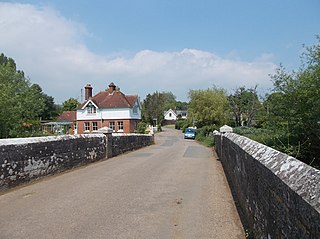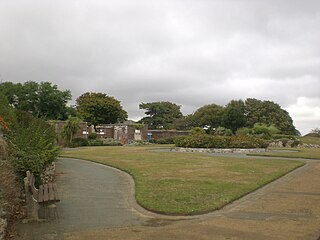
The Isle of Wight is an island in the English Channel, 2 to 5 miles off the coast of Hampshire, across the Solent. It is the largest and second-most populous island in England. Referred to as "The Island" by residents, the Isle of Wight has resorts that have been popular holiday destinations since Victorian times. It is known for its mild climate, coastal scenery, and verdant landscape of fields, downland, and chines. The island is historically part of Hampshire and is designated a UNESCO Biosphere Reserve.

Sandown is a seaside resort town and civil parish on the south-east coast of the Isle of Wight, United Kingdom with the resort of Shanklin to the south and the settlement of Lake in between. Together with Shanklin, Sandown forms a built-up area of 21,374 inhabitants.

The Detroit Zoo is a zoo located in the cities of Huntington Woods and Royal Oak in the U.S. state of Michigan. Spanning 125 acres (50.6 ha), it houses more than 2,000 animals and more than 245 different species. It was the first U.S. zoo to feature bar-less habitats, and is regarded to be an international leader in animal welfare, conservation and sustainability by the Detroit Zoological Society.

Dinosaur Isle is a purpose-built dinosaur museum located in Sandown on the Isle of Wight in southern England.

Arreton is a village and civil parish in the central eastern part of the Isle of Wight, England. It is about 3 miles south east of Newport.
The Isle of Wight is one of the richest dinosaur localities in Europe, with over 20 species of dinosaur having been recognised from the early Cretaceous Period, some of which were first identified on the island, as well as the contemporary non-dinosaurian species of crocodile, turtle and pterosaur.

Katherine Mary Humble is an English television presenter and narrator, mainly working for the BBC, specialising in wildlife and science programmes. Humble served as president of the Royal Society for the Protection of Birds from 2009 until 2013. She is an ambassador for the UK walking charity Living Streets.

Amazon World Zoo Park is a medium-sized zoo located in Newchurch, Isle of Wight on the outskirts of Sandown, England.

In British folklore and urban legend British big cats refers to the subject of reported sightings of non-native, typically large felids feral in the United Kingdom. Many of these creatures have been described as "panthers", "pumas" or "black cats".

Yaverland is a village and former civil parish, now in the parish of Sandown, on the Isle of Wight, England. It is just north of Sandown on Sandown Bay. It has about 200 houses. About 1⁄3 of a mile away from the village is the Yaverland Manor and Church. Holotype fossils have been discovered here of Yaverlandia and a pterosaur, Caulkicephalus. The White Air extreme sports festival was held annually at Yaverland pay and display car park between 1997 and 2008, but moved to Brighton for 2009.

Alverstone is a village 2 miles from the east coast of the Isle of Wight, near Sandown. When Richard Webster became Chief Justice of England in 1900, he chose the title Lord Alverstone because it was the title he was permitted to choose which was "closest" to Sandown, one of his favourite locales. Alverstone Manor is located here.

The Wildheart Sanctuary, previously known as the Isle of Wight Zoo and Sandown Zoo, is a sanctuary inside the former Sandown Fort on the coastline of Sandown, Isle of Wight. The zoo was privately owned but became a charitable trust in 2017. The collection focuses principally on big cats and Madagascan animals.

Ryde Academy is an academy status secondary school, including sixth form, located in Ryde on the Isle of Wight, England.
Sandown Bay Academy, formerly Sandown High School, was an academy status secondary school located in Sandown on the Isle of Wight, England. From 2012 to 31 August 2018 it was sponsored by the Academies Enterprise Trust. On 31 August 2018, the academy closed.

Sandown Fort is a fort built in Sandown on the Isle of Wight in the middle of Sandown Bay. It is one of the many Palmerston Forts built on the island to protect it in response to a perceived French invasion. It was a replacement of the earlier Sandown Diamond Fort as in 1859 the Royal Commission felt it did not offer suitable protection. Construction of the fort began in April 1861 and was completed by September 1864 at a cost of £73,876. In later documents it is often referred to as Granite Fort. The fort originally had 18 9-inch R.M.L guns facing the sea behind iron shields, these guns were later upgraded and an extra 5 inches of armor was added.

Sandown Barrack Battery is a battery located in Sandown Bay close to Sandown on the Isle of Wight in England. It is one of the many Palmerston Forts built on the island to protect it in response to a perceived French invasion.

Bembridge Fort is a fort built on the highest point of Bembridge Down close to the village of Bembridge on the Isle of Wight, England. It is one of the many Palmerston Forts built around Portsmouth during the period of the Second French Empire, as a safeguard against a perceived threat of French invasion by Napoleon III.

A Carnot wall is a type of loop-holed wall built in the ditch of a fort or redoubt. It takes its name from the French mathematician, politician, and military engineer, Lazare Carnot. Such walls were introduced into the design of fortifications from the early nineteenth century. As conceived by Carnot they formed part of an innovative but controversial system of fortification intended to defend against artillery and infantry attack. Carnot walls were employed, together with other elements of Carnot's system, in continental Europe in the years after the final defeat of Napoleon in 1815, especially by the Prussians, other Germans and Austrians. Their adoption was initially resisted by the French themselves and by the British.
The Shit Museum is a museum in the province of Piacenza, in the north of Italy, and is reported to be the world's first museum dedicated to faeces. The museum opened on 5 May 2015, having been founded by agricultural businessman Gianantonio Locatelli and three associates.

Robert William Henry Seely is a British Conservative Party politician who has served as the Member of Parliament (MP) for the Isle of Wight since June 2017. He was re-elected at the general election in December 2019 with an increased vote and majority. Seely is a former journalist and soldier. From 1990 to 1995, he worked as a foreign correspondent in the USSR/post-Soviet states. From 2008 to 2017, he served in the British Armed Forces on the Iraq, Afghanistan, Libya and ISIS campaigns.

























